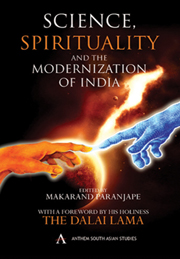Book contents
- Frontmatter
- Contents
- Notes on Contributors
- Foreword
- Editor's Preface
- I Science and Spirituality: East and West
- II Coming to Terms with Science: Some Change Agents
- III Building Bridges: Evolution, Consciousness and Healing
- CHAPTER 8 The Concept of the Yuga: Modern Scientific Approaches to Bridge Spiritual and Philosophical Concepts
- CHAPTER 9 Sri Aurobindo's Concept of Evolution of Consciousness: Exploration through the Paradigm of Health and Disease
- CHAPTER 10 The Blending of Science and Spirituality in the Ayurvedic Tradition of Healing
- CHAPTER 11 Micro-sensing by Indian Mystics
- CHAPTER 12 The Big Picture for the Science of Consciousness
- IV Science and Spirituality: Culture, Society and Gender
CHAPTER 11 - Micro-sensing by Indian Mystics
from III - Building Bridges: Evolution, Consciousness and Healing
Published online by Cambridge University Press: 05 March 2012
- Frontmatter
- Contents
- Notes on Contributors
- Foreword
- Editor's Preface
- I Science and Spirituality: East and West
- II Coming to Terms with Science: Some Change Agents
- III Building Bridges: Evolution, Consciousness and Healing
- CHAPTER 8 The Concept of the Yuga: Modern Scientific Approaches to Bridge Spiritual and Philosophical Concepts
- CHAPTER 9 Sri Aurobindo's Concept of Evolution of Consciousness: Exploration through the Paradigm of Health and Disease
- CHAPTER 10 The Blending of Science and Spirituality in the Ayurvedic Tradition of Healing
- CHAPTER 11 Micro-sensing by Indian Mystics
- CHAPTER 12 The Big Picture for the Science of Consciousness
- IV Science and Spirituality: Culture, Society and Gender
Summary
Patanjali wrote his master treatise on meditation about 2,500 years ago. Buddha and Mahavir date around the same time. The Hindu, Buddhist and Jain traditions evolved their own tantrik practices. By following a particular method it was implied that specific and certain results could accrue. If this was to uniformly and universally happen, it would mean the practice of a scientific methodology. When it is not easy to replicate or repeat them, the events will have to be explained. Till such an explanation is forthcoming, such events will be called paranormal occurrences that are paranormal within the limitations of our knowledge.
Patanjali describes that in the process of Sadhana along the Raj Yoga route, eight Siddhis incidentally accrue. Most of these phenomena are unusual and fall in the category of paranormal occurrences. It is difficult to validate them. But there are authentic records of investigations by some mystics – occultists that point to the fact that they did succeed in exercising such powers. If paranormal phenomena do occur, the only explanation that can support them has to be an extrasensory extension of transpersonal, trans-spatial and trans-temporal faculties.
The incidents of spontaneous extrasensory perception (ESP) are infrequent, fleeting and ambiguous so they are impossible to reproduce dependably. This is genuine criticism as far as scientific study is concerned. ESP and paranormal occurrences cannot be generated at will. They just happen. But even a single event in nature requires explanation by its eventuality.
- Type
- Chapter
- Information
- Science, Spirituality and the Modernisation of India , pp. 181 - 188Publisher: Anthem PressPrint publication year: 2009

